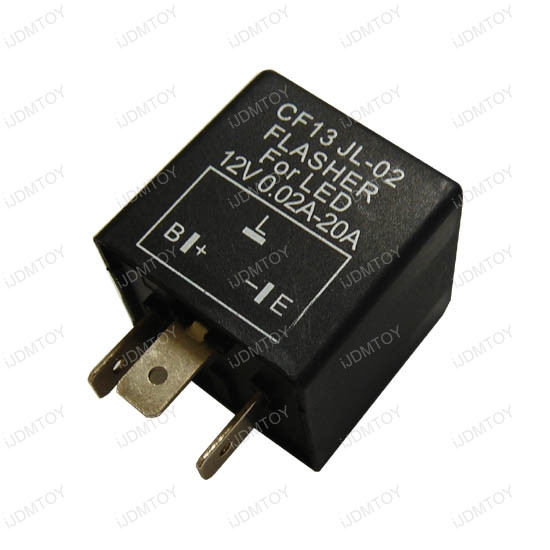Apparently most Jap cars are the other way around to Euros.
If your relay is this layout its the wrong one, VWs need positive on the right.


Hi All,
Decided to change to LED lights in the hope they'd be brighter and draw less power. The brake and reverse lights work brilliantly, but I'm having
dramas with the indicators.
Here's what I've tried so far.
1. Replace one globe and the indicators flash much faster (no surprise there).
2. Replace both globes and only one of the individual LEDs light up in each globe.
So I decided to replace the flasher relay with an LED specific one. Admittedly it's a relatively cheap one from Ebay. I've tried it all combinations
with both the LED globes and normal globes and absolutely nothing happens. I'm guessing that the relay is a dud.
But, before I go out and buy another relay, I thought I'd ask if there were any other ideas of what I should try.
Car is an LBug/1303 so the relay sits behind the fuses under the dashboard. The relay was in the first position, whilst the Bentleys says it should be
in position 3 (again not a big surprise).
Thanks
Craig
Maybe the new relay has a different wiring configuration?
I think it cause they use less power allowing them to flash faster, just like in a newer car when one globes blows the blinkers flash faster on the side that the globes blown .
As Steve said its probably the terminal layout is wrong, I know when I fitted my LED flasher it was the wrong way around for VWs, i had to switch the
wires around in fuse box.
Apparently most Jap cars are the other way around to Euros.
If your relay is this layout its the wrong one, VWs need positive on the right.

| Quote: |
you can also fit a dummy load and use the standard flasher can. http://www.ebay.com.au/itm/LED-LOAD-RESISTORS-FOR-VEHICLES-NOT-LED-COMPATIBLE...
If you have the old bulb and it ain't blown then measure it's resistance. Then buy a 1/2W resistor slightly lower than the bulbs resistance and wire
it in parallel to the LED bulb. This should pull the overall load down to where the relay flashes much closer to the original time period. 
The bulbs resistance needs to be measured when the globe is hot as globes have a positive temperature coefficient and the resistance varies greatly
with temperature. Better to use ohm's law. The resistor that you will need is 36 watts as it is replacing two 18 watt globes.
Much easier to buy a dummy load as vwo60 said.
Better for heat dissipation to wire the resistor at each bulb and not just one resistor for each side.
1/2W should be fine, of I've remembered my degree tech labs properly, but 1W to be safer as due to the flashing nature of the indicator the resistor
isn't having to dissipate as much heat.
The resistor method is just a neater solution than trying to wire the additional ordinary style bulbs in parallel with the LED ones.
Least the OP has a few options to try now 
| Quote: |
The inline resistor is a no brainer and available over the counter, use the kiss principal.
The extra resistor will also mean that the total current draw on the electrics will be the same as if you were using a normal bulb as well.
I agree with the KISS principle.......
| Quote: |

| Quote: |
| Quote: |
6 volt were 18w is probaby what you were thinking of.
| Quote: |
Craig,
The problem with using LEDs is that the original flasher relays relied on the current of the globes to make them flash. As LEDs are very efficient and
use only a tiny amount of power the current is not enough to make them flash correctly.
Craig you have four options.
1/ Use an LED flasher unit and mount it in the fuse panel and change the connections. The connectors in the fuse panel can be released by pushing a
small jeweler's screwdriver down the back of the lug to release it.
2/ Use an LED flasher unit and mount it remotely using a short loom with male connectors for the fuse panel socket end and female connectors to the
relay.
3/ Use a load resistor that is commercially available for this purpose.
4/ Use a load resistor that you obtain yourself and wire it in parrallel with the LEDs.
To select a suitable load resistor you will need to calculate the resistance using Ohm's law.
You already know that the nominal voltage is 12 volts and the globes are 21 watts each.
To calculate the current you can divide the wattage by the voltage and the multiply by 2 as they are connected in parrallel.
21/12 x 2 = 3.5 amps.
Ohm's law is R=V/I R = 12/3.5 which equals 3.4 ohms.
To calculate the wattage of the resistor you will need to multiply the voltage by the current which is 12V x 3.5A = 42 Watts
So you will need a 3.4 ohm 42 watt resistor.
Thank you 
The maths is correct for a constant load but I had LED bulbs back at Uni some 12yrs ago and did the calculations then and was able to get away with 1W
resistors. Could of been 5W but pretty sure 1 was enough per bulb and worked happily until I sold the Bug a year or so later 
Craig, you can buy resistors at Repco specifically made for fitting LED indicators. It is a common practice on utes and 4by's to change at least the
rear light clusters to LED and Narva make a specific resistor to suit. Probably an expensive way to do it, but easy as.
Cheers
| Quote: |

| Quote: |

